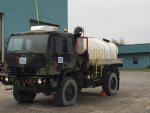Those window units ACs are able to produce a lot of cooling. Some people hack them to build massive walkin freezers/fridges. I don't think the BTU load in the worse condition is enough to exhaust an average sized window unit, the smallest ones are 5000 BTU. It will likely cycle on an off too often. It is all based on BTU load. A real AC guy can calculate the worse case load. The engine driven units look better but at 25-40 times the price it is a decision.
A 1 ton house hole AC is 12,000 BTU. I have seen many 2000sq ft homes with only 2.0 ton units or 24,000 BTU of cooling. (12 BTU per sq ft) The Cab of a LMTV is less the 50 sq ft so a 5000 BTU window unit would provide 100 BTU per sq ft. The 5000 BTU units are usually under $150.00.
That's pretty much all wishful thinking, and ignoring the obvious that vehicles routinely come with 20,000-30,000 BTU heating/cooling systems for a reason. There really isn't a need to speculate on how or why that's what it takes, or compare to well insulated houses and fridges, because you can see empirically that the A/C in your daily driver isn't overkill. The people who have designed this stuff hundreds of times over have established that is what it reasonably takes.
Keep in mind that 5000 BTU home window unit also runs on like 15A @ 110VAC, or 1650W. That's 137.5A @ 12VDC, so you're still outrunning even a beefy upgraded alternator, or what you could get from solar on the roof of an M1079, or both combined really. And that's not even factoring in that if you have to run it through a DC-to-AC inverter you're probably losing another 20% efficiency. Even the alternator upgrades are a couple grand too. Even if the 5000 BTU A/C was 100% efficient (and it's probably nowhere close), 5000 BTU = 1.46 kWh (in terms of unit conversion), which aligns with those amperage draws.
While I would love for there to be some easy and cheap solution for you to find, I think you should have been really skeptical of one the second you started looking around and started to seeing how expensive and how much power all this stuff uses (in it's conventional off the shelf form). It's like posting up that you want to make your car get 100MPG... if it was that easy, all the cars would come that way (conspiracy theories about the gov't keeping us dependent on oil aside). You just can't escape the physics of it. Maybe a fantastic insulating strategy would help you be able to use a very small A/C unit?



